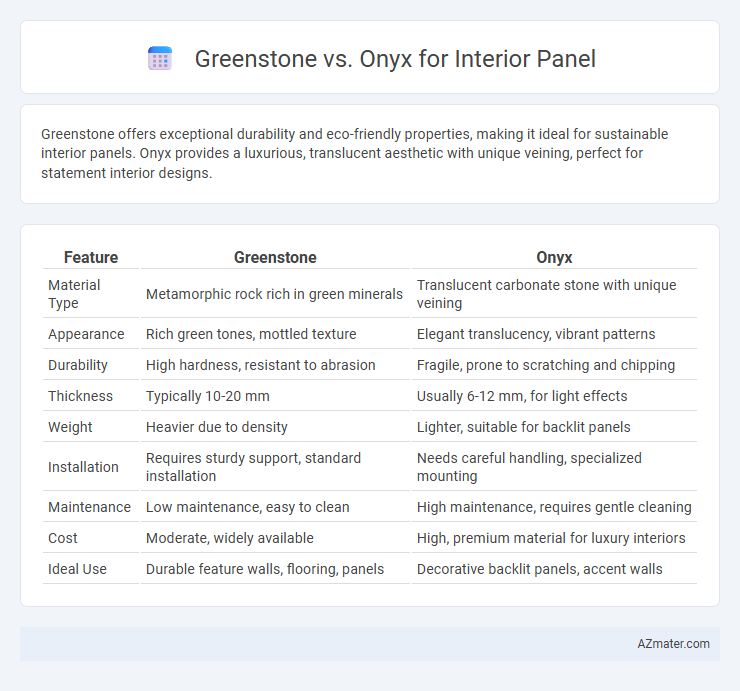Greenstone offers exceptional durability and eco-friendly properties, making it ideal for sustainable interior panels. Onyx provides a luxurious, translucent aesthetic with unique veining, perfect for statement interior designs.
Table of Comparison
| Feature | Greenstone | Onyx |
|---|---|---|
| Material Type | Metamorphic rock rich in green minerals | Translucent carbonate stone with unique veining |
| Appearance | Rich green tones, mottled texture | Elegant translucency, vibrant patterns |
| Durability | High hardness, resistant to abrasion | Fragile, prone to scratching and chipping |
| Thickness | Typically 10-20 mm | Usually 6-12 mm, for light effects |
| Weight | Heavier due to density | Lighter, suitable for backlit panels |
| Installation | Requires sturdy support, standard installation | Needs careful handling, specialized mounting |
| Maintenance | Low maintenance, easy to clean | High maintenance, requires gentle cleaning |
| Cost | Moderate, widely available | High, premium material for luxury interiors |
| Ideal Use | Durable feature walls, flooring, panels | Decorative backlit panels, accent walls |
Introduction to Greenstone and Onyx
Greenstone and Onyx are both premium materials used for interior panels, each offering unique aesthetic and functional qualities. Greenstone features a natural, earthy appearance with rich green hues and mineral patterns, making it a popular choice for creating a calming and sophisticated interior ambiance. Onyx is prized for its translucent properties and vibrant color variations, allowing backlighting designs that enhance luxury and visual depth in interior spaces.
Material Composition and Characteristics
Greenstone interior panels are primarily composed of natural stone with high quartz content, offering exceptional hardness and resistance to scratching, making them ideal for durable surfaces. Onyx panels feature a translucent composition mainly of calcite crystals, providing unique visual appeal through its natural light-diffusing properties but require careful handling due to their relative softness and brittleness. Both materials enhance interior aesthetics but differ significantly in strength, translucency, and maintenance requirements.
Aesthetic Appeal: Color and Texture
Greenstone interior panels offer a unique aesthetic appeal with their natural hues ranging from soft greens to deep emeralds, providing a calming, earthy ambiance. Onyx panels stand out with their translucent qualities and rich color variations, including warm ambers and vibrant reds, allowing for dramatic backlighting effects that enhance texture depth. Both materials deliver distinct visual experiences, with Greenstone emphasizing organic texture and subdued tones, while Onyx offers bold color vibrancy and intricate veining patterns.
Durability and Longevity
Greenstone interior panels offer exceptional durability due to their natural mineral composition, resisting scratches, heat, and moisture effectively in high-traffic areas. Onyx panels, while prized for their stunning translucence and aesthetic appeal, tend to be softer and more prone to chipping and wear over time compared to Greenstone. For long-lasting interior installations, Greenstone provides superior longevity backed by its robust physical properties and low maintenance requirements.
Installation and Maintenance Requirements
Greenstone interior panels offer straightforward installation with interlocking edges and lightweight design, reducing labor time and costs. Onyx panels require precise handling and professional installation due to their heavier weight and fragility, increasing initial setup complexity. Maintenance for Greenstone involves simple cleaning with mild detergent, while Onyx demands careful upkeep to preserve its glossy finish and avoid scratches, often requiring specialized cleaning products.
Cost Comparison and Budget Considerations
Greenstone interior panels typically cost 15-20% less than Onyx panels, making them a more budget-friendly option for large-scale projects. Onyx offers a luxurious, translucent appearance with higher material and installation costs that can exceed $100 per square foot, compared to Greenstone's average range of $80-$90 per square foot. Budget considerations should factor in not only the upfront cost but also long-term durability and maintenance expenses, where Greenstone generally requires less upkeep than Onyx.
Environmental Impact and Sustainability
Greenstone interior panels are renowned for their eco-friendly composition, often made from recycled materials and low-VOC resins, which significantly reduce indoor air pollution and carbon footprint. Onyx panels, while visually striking, typically involve more energy-intensive manufacturing processes and use non-renewable resources, leading to a higher environmental impact. Choosing Greenstone supports sustainability goals by promoting resource efficiency and reducing waste in interior design projects.
Popular Design Applications in Interiors
Greenstone panels are favored for their natural, textured appearance, making them ideal for organic, rustic, and eco-friendly interiors. Onyx panels, celebrated for their translucency and dramatic veining, are popular in luxury settings such as feature walls, backlit bars, and elegant bathroom designs. Both materials offer unique aesthetic appeal, with Greenstone providing earthy warmth and Onyx delivering sophisticated luminosity in interior design projects.
Pros and Cons of Greenstone Panels
Greenstone panels offer exceptional durability, natural stone aesthetics, and excellent thermal insulation, making them ideal for long-lasting interior applications in both residential and commercial spaces. However, they tend to be heavier and more expensive than synthetic alternatives like Onyx, which can increase installation complexity and overall project costs. Maintenance for Greenstone requires periodic sealing to prevent staining, whereas Onyx panels are typically easier to clean but less resistant to scratches and impact.
Onyx Panels: Advantages and Disadvantages
Onyx panels offer a luxurious and translucent appearance, making them ideal for creating stunning interior features with backlighting effects. Their natural translucency enhances ambient lighting, but Onyx is softer and more brittle compared to Greenstone, requiring careful handling and maintenance. While Onyx panels are visually striking and unique, they tend to be more expensive and less durable, impacting their suitability for high-traffic or heavy-use areas.

Infographic: Greenstone vs Onyx for Interior Panel
 azmater.com
azmater.com